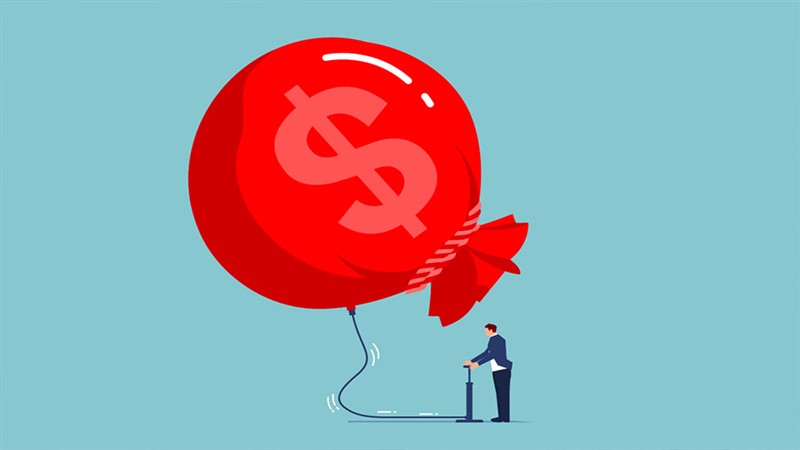2023.02 The Taiwan Banker NO.158 / By Chi-Chau Lin
Taming the inflation monsterBanker's Digest
Inflation was the most important key to the economy in 2022. Due to high inflation, the US Federal Reserve (Fed) vigorously raised rates, and the ensuing economic slowdown and financial turmoil became the main theme of the year. The course of inflation will also remain the primary consideration for this coming year.Triggers vary by countryInflation has manifested in different ways in different countries. In Europe, it has been mainly caused by energy; the correlation between inflation and electricity prices has been more than 90%. The gas cut-off triggered by the Ukraine War caused energy and electricity prices in the euro zone to soar. Germany has been hit particularly hard. Although inflation seems to have peaked in the past two months, the risk of stagnation should not be ignored if the European Central Bank is forced to raise rates.In Japan, due to the surge in energy prices and depreciation of the exchange rate, imports inflation rose to 50% in July, slowly reducing the growth rate. But with imports inflation leading headline inflation by about nine months, inflation is likely to rise above 4% in the first half of the year. This also forced Japan, which has the loosest monetary policy among advanced economies, to raise the upper limit of the 10-year government bond rate by 0.25% to 0.5% at the end of last year, a big step towards normalization. Further adjustment could not only give the yen room to appreciate, but might also cause disturbances in the financial market.As for the US, which has the most important influence on global capital trends, CPI inflation grew at an annual growth rate of 6.5% in December, the lowest since October 2021, and will likely continue to decline. In fact, inflation in physical commodities reached a high and fell as early as February 2022, and the base period effect of energy has gradually slowed down: if the oil price remains at 70 to 90 US dollars per barrel throughout the year, the annual rate of decline will decrease in the middle of the year. Prices of services, including rent and wages, which account for nearly 60% of inflation, have however continued to rise (Figure 1). Therefore, service inflation should be the focus of observation. Source: US Bureau of Labor StatisticsRegarding rent, annual growth reached 7.5% in December, but considering that the mortgage rate was at least 3%-3.5% higher than that at the end of 2021, and housing prices fell by more than 3% since mid-2022, there is still room for decline. The annual growth rate in overall rent should be seen as high, and will likely weaken in a few months. The core Personal Consumption Expenditures (PCE) inflation, which the Federal Reserve is most concerned about, and which accounts for more than half of the service category, is clearly linked with wages (Powell 2022).Structural imbalances in the labor marketWhen it comes to wages, it is necessary to examine the structural changes in the labor market caused by the pandemic. The recent news in Taiwan of chairmen personally carrying their own luggage and general managers laying their own sheets shows this imbalance. Figure 2 shows the supply and demand of the labor market in the US from 1980 to 2022. Demand is based on job openings plus employment, and supply is based on labor force. For the past 40 years, there has never been a situation where the demand for labor greatly has exceeded the supply. As of November 2022, however, that shortfall will be about 4.4 million people.Source: US Census Bureau, Bureau of Labor StatisticsThere are two main reasons for this gap. The first is excess retirement. According to Montes, Smith and Dajon (2022), this has reduced the labor force by nearly 2 million people compared with the previous trend. The pandemic may be related to health factors, or seniors may have been dismissed early in the pandemic, and found it difficult to return. There were also early retirements due to the boom in the stock market and housing markets from 2020-2021. The second is slow growth of the working-age population, including a sharp drop in immigration and increase in mortality, which has also reduced the labor force by nearly 1 million compared to the trend (Powell 2022).This gap means rising salary pressure. Measured by different indicators, the current salary growth rate is about 4.5%-6.5% (Figure 3). From 2010-2022, the relationship between monthly shortage of workers in the US ((labor demand minus labor supply) divided by labor supply) has generally been positively associated with growth of service sector wages. As the labor force is not likely to see a substantial increase in the short term, changes in labor demand, especially job vacancies, will become key. From February-November 2022, the number of openings fell by nearly 1.4 million. If the economic climate continues to slow, vacancies will further decrease over the next few quarters, which will help alleviate pressure on wages. Nevertheless, wage growth in services may remain high in the short term, and it will take some time for service inflation to slow down. Broadly, salary levels will continue to increase over the next few years.Notes: The x-axis is the US labor supply gap, i.e. (labor demand minus labor supply) divided by labor supply; positive values indicate that demand is greater than supply. The y-axis is growth in US service sector wages (Atlanta Fed Wage Tracker). Period: 2010.1-2022.11.Source: US Census Bureau, Bureau of Labor Statistics, Federal Reserve Bank of Atlanta, calculations by author.Inflation is always and everywhere a monetary phenomenonOverall, US inflation is likely to slow. Borrowing from Milton’s Friedman’s famous saying that “inflation is always and everywhere a monetary phenomenon,” current growth of the M2 money supply in the US is close to negative. With a significant lag effect in monetary policy, the same trend may also occur in inflation (Figure 4). Assuming no major supply chain shocks and oil prices in the $70-$90/bbl range, we expect inflation to ease back below 4.5% by mid-year (with lower PCE inflation) and below 3.5% by year-end. Although this is still above the 2% inflation target, if the Fed raises by 0.25% each on February 1 and March 22, it means that the policy rate will increase from the current 4.5% to 5%. That is to say, it is very likely that in Q2, the nominal policy interest rate level will be greater than inflation, and the real policy interest rate level (defined here as the nominal interest rate minus PCE inflation) will turn from negative to positive.Note: Correlation between M2 growth rate (leading 18 months) and PCE over the past 10 years (2012.1-2022.11) = 0.83 (0.86 for core PCE)Source: FREDIn September, Fed Chair Powell stated that he hopes to raise interest rates until “the real yield curve is positive.” Since the current yield curve is inverted, i.e. short-term rates are higher than long-term rates, when the real policy rate becomes positive, it will be almost certain that real rates of all maturities will also be positive. Crossing over from negative to positive does not mean that inflation will take a turn for the worse, but whether in terms of real or psychological terms, real rates do affect credit and real economic activity. Thus, March 22 or May 3 is likely to be the end of this cycle of rate hikes. In the half-year after the previous two hike cycles (2006 and 2018), the real policy rate was around 1.5%-2%. If PCE inflation is 3%-3.5% at the end of the year, it means that the real policy rate will be about 1.5%-2% in H1 following the current wave of hikes (March or May).The end of rate hikes doesn't mean the beginning of cuts However, the end of rate hikes will not mean the start of cuts. After all, the inflation monster has not yet been tamed. The deferred effect of monetary policy will cause the Fed pay to more attention to three things in the future. First, the speed and extent of the economic downturn, especially unemployment. From the simple Sahm’s law (Sahm 2018), historical experience shows that if the unemployment rate jumps to 4.1%-4.2% or higher in the next few quarters – 0.5% higher than the recent rate – the economy should fall into recession. The Fed estimates that unemployment will reach 4.6% this year. This has not yet shown up in the figures, but the time simply has not yet come. Unless the recession is so severe as to create systemic risks to the financial system, it is unlikely that the Fed will cut rates immediately after ending their increase, let alone engage in QE.Second, three structural changes – localization, “slowbalization,” and deglobalization – have triggered rising costs. “Globalization never dies, it just fades away.” The energy transformation and sharp shrinkage of the labor force over the past three years caused an imbalance between supply and demand and rise in wage costs. These three trends are all biased towards the supply side, and have a weak relationship with the inventory adjustment of the business cycle, which means that the weight of the supply side may be greater than in the past few decades in forming long-term inflation expectations. If this is the case, monetary policy may not be the most powerful factor in the economy, and even determining the most appropriate inflation target may be more difficult than in the past. Third, the impact of China’s reopening on global inflation, coupled with policy incentives to guarantee housing delivery and efforts to promote internal demand, which will support the price of raw materials, needs to be closely monitored.Inflation is strange and unpredictable. Changes in inflation expectations caused by the unfamiliar supply-side impact of the pandemic on the labor market and the aftermath of large-scale fiscal and monetary policies will be worth writing about in future economics textbooks, including in Taiwan. The author of this article is Chief Economist of Cathay United Bank.


